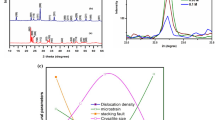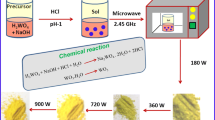Abstract
The controlled preparation of hexagonal tungsten trioxide (h-WO3) nanostructures was achieved by adjusting the pH of the precursor solution. The effect of the pH on the morphology, elemental composition, and photocatalytic performance of the samples was characterized via X-ray diffraction (XRD), scanning electron microscopy, energy dispersive X-ray spectroscopy, and Raman spectroscopy. Ultraviolet–visible (UV–Vis) spectra were used to evaluate the absorbance and the photocatalytic performance of methylene blue. Photoluminescence (PL), electrochemical impedance spectroscopy, photocurrent response and Brunauer–Emmett–Teller (BET) were used to study the optical properties, electrical performance, and specific surface area of the WO3- nanostructures, respectively. The results indicate that the WO3 nanorods prepared at pH = 1.0 exhibit the highest photocatalytic performance (87.4% in 1 h), whereas the WO3 nanoblocks prepared at pH = 3.0 show the lowest. The photocatalytic performance of the one dimensional (1D)-nanorods can be attributed to their high specific surface area and charge transfer ability. The h-WO3 nanostructures were synthesized via a simple method and without a capping agent. They show an excellent photocatalytic performance, which is promising for their application in environment purification.








Similar content being viewed by others
References
Tahir MB, Nabi G, Rafique M, Khalid NR. Nanostructured-based WO3 photocatalysts: recent development, activity enhancement, perspectives and applications for wastewater treatment. Int J Environ Sci Tecnol. 2017;14(11):2519.
Dumrongrojthanath P, Phuruangrat A, Thongtem S, Thongtem T. Facile sonochemical synthesis and photocatalysis of Ag nanoparticle/ZnWO4-nanorod nanocomposites. Rare Met. 2019;38(7):601.
Ping M, Qiu S, Wei G, Liu J, Wang Z, Wang S, An C. Monolith free-standing plasmonic PAN/Ag/AgX (X = Br, I) nanofiber mat as easily recoverable visible-light-driven photocatalyst. Rare Metals. 2019;38(5):361.
Zhang Y, Yang J, Yu X. Preparation, characterization, and adsorption-photocatalytic activity of nano TiO2 embedded in diatomite synthesis materials. Rare Met. 2017;36(12):987.
Liu Y, Wei S, Gao W. Ag/ZnO heterostructures and their photocatalytic activity under visible light: effect of reducing medium. J Hazard Mater. 2015;287:59.
Shi Y, Liu S, Zhang Y, Sun M, Tang K. Construction of WO3/Ti-doped WO3 bi-layer nanopore arrays with superior electrochromic and capacitive performances. Tungsten. 2019;1(3):236.
Mohamed MM, Salama TM, Hegazy MA, Abou Shahba RM, Mohamed SH. Synthesis of hexagonal WO3 nanocrystals with various morphologies and their enhanced electrocatalytic activities toward hydrogen evolution. Int J Hydrogen Energy. 2019;44(10):4724.
Yang J, Xiao J, Cao H, Guo Z, Rabeah J, Brueckner A, Xie Y. The role of ozone and influence of band structure in WO3 photocatalysis and ozone integrated process for pharmaceutical wastewater treatment. J Hazard Mater. 2018;360:481.
Xiong Y, Zhu Z, Guo T, Li H, Xue Q. Synthesis of nanowire bundle-like WO3-W18O49 heterostructures for highly sensitive NH3 sensor application. J Hazard Mater. 2018;353:290.
Shao X, Wang H, Yuan M, Yang J, Zhan W, Wang L, Guo Y, Lu G. Thermal stability of Si-doped V2O5/WO3-TiO2 for selective catalytic reduction of NOx by NH3. Rare Met. 2019;38(4):292.
Wang Y, Liu T, Li H, Liu B, Yang L. Tungsten-based photocatalysts with UV–Vis–NIR photocatalytic capacity: progress and opportunity. Tungsten. 2019;1(4):247.
Peeters D, Reyes OM, Mai L, Sadlo A, Cwik S, Rogalla D, Becker HW, Schuetz HM, Hirst J, Mueller S, Friedrich D, Mitoraj D, Nagli M, Toroker MC, Eichberger R, Beranek R, Devi A. CVD-grown copper tungstate thin films for solar water splitting. J Mater Chem A. 2018;6(22):10206.
Hunge YM, Yadav AA, Mahadik MA, Mathe VL, Bhosale CH. A highly efficient visible-light responsive sprayed WO3/FTO photoanode for photoelectrocatalytic degradation of brilliant blue. J Taiwan Inst Chem E. 2018;85:273.
Anithaa AC, Asokan K, Sekar C. Low energy nitrogen ion beam implanted tungsten trioxide thin films modified indium tin oxide electrode based acetylcholine sensor. J Taiwan Inst Chem E. 2018;84:11.
Kumar KU, Bhat SD, Subrahmanyam A. Electrochromic device with magnetron sputtered tungsten oxide (WO3) and nafion membrane: performance with varying tungsten oxide thickness- a report. Mater Res Express. 2019;6(4):045513.
Chen D, Ye J. Hierarchical WO3 hollow shells: dendrite, sphere, dumbbell, and their photocatalytic properties. Adv Funct Mater. 2008;18(13):1922.
Zhou Q, Chen Y, Li X, Qi T, Peng Z, Liu G. Preparation and electrochromism of pyrochlore-type tungsten oxide film. Rare Metals. 2018;37(7):604.
Wang Y, Meng Z, Chen H, Li T, Zheng D, Xu Q, Wang H, Liu XY, Guo W. Pulsed electrochemical deposition of porous WO3 on silver networks for highly flexible electrochromic devices. J Mater Chem C. 2019;7(7):1966.
Rozman M, Bren U, Luksic M, Godec RF, Bokias G, Kalarakis AN, Stathatos E. Electrochromic cell with hydrogel-stabilized water-based electrolyte using electrodeposition as a fast color changing mechanism. Electrochim Acta. 2018;283:1105.
Zhang Y, Zhang D, Xu X, Zhang B. Morphology control and photocatalytic characterization of WO3 nanofiber bundles. Chin Chem Lett. 2018;29(9):1350.
Dong P, Hou G, Xi X, Shao R, Dong F. WO3-based photocatalysts: morphology control, activity enhancement and multifunctional applications. Environ Sci Nano. 2017;4(3):539.
Wei Z, Zhou Q, Lu Z, Xu L, Gui Y, Tang C. Morphology controllable synthesis of hierarchical WO3 nanostructures and C2H2 sensing properties. Physica E. 2019;109:253.
Li Y, Tang Z, Zhang J, Zhang Z. Fabrication of vertical orthorhombic/hexagonal tungsten oxide phase junction with high photocatalytic performance. Appl Catal B. 2017;207:207.
Ryu S, Nam C. Adsorption characteristics of methylene blue on WO3 nanorods prepared by microwave-assisted hydrothermal methods. Phys Status Solidi A. 2018;215(20):1700996.
Li Y, Zhou R, Zhou Y, Wang Y, Wang C, Ling Q, Niu H, Zhang W, Qiu J, Guo Z, Xu J. Au nanoparticle-decorated urchin-like TiO2 hierarchical microspheres for high performance dye-sensitized solar cells. Electrochim Acta. 2019;293:230.
Cao S, Li H, Tong T, Chen H, Yu A, Yu J, Chen HM. Single-atom engineering of directional charge transfer channels and active sites for photocatalytic hydrogen evolution. Adv Funct Mater. 2018;28(32):1802169.
Li J, Liu X, Cui J, Sun J. Hydrothermal synthesis of self-assembled hierarchical tungsten oxides hollow spheres and their gas sensing properties. Acs Appl Mater Inter. 2015;7(19):10108.
Zhang X, Dou S, Li W, Wang L, Qu H, Chen X, Zhang L, Zhao Y, Zhao J, Li Y. Preparation of monolayer hollow spherical tungsten oxide films with enhanced near infrared electrochromic performances. Electrochim Acta. 2019;297:223.
Nakakura S, Arif AF, Rinaldi FG, Hirano T, Tanabe E, Balgis R, Ogi T. Direct synthesis of highly crystalline single-phase hexagonal tungsten oxide nanorods by spray pyrolysis. Adv Powder Technol. 2019;30(1):6.
Gong Y, Zheng F, Dong J, An P, Yang D, Guo Z, Li H, Li Y, Li X. Structural changes in hexagonal WO3 under high pressure. J Alloy Compd. 2019;797:1013.
Kumar VB, Mohanta D. Formation of nanoscale tungsten oxide structures and colouration characteristics. B Mater Sci. 2011;34(3):435.
Nagy D, Nagy D, Szilágyi IM, Fan X. Effect of the morphology and phases of WO3 nanocrystals on their photocatalytic efficiency. RSC Adv. 2016;6(40):33743.
Farjood M, Zanjanchia MA. Template-free synthesis of mesoporous tungsten oxide nanostructures and its application in photocatalysis and adsorption reactions. Chemistryselect. 2019;4(11):3042.
Wang C, Fan H, Ren X, Fang J, Ma J, Zhao N. Porous graphitic carbon nitride nanosheets by pre-polymerization for enhanced photocatalysis. Mater Charact. 2018;139:89.
Abdallah B, Hussein R, Al-Kafri N, Zetoun W. PbS thin films prepared by chemical bath deposition: effects of concentration on the morphology, structure and optical properties. Iranian J Sci Technol Trans A Sci. 2019;43(3):1371.
Hai G, Huang J, Cao L, Jie Y, Li J, Wang X, Zhang G. Influence of oxygen deficiency on the synthesis of tungsten oxide and the photocatalytic activity for the removal of organic dye. J Alloy Compd. 2017;690:239.
Liu X, Fan H. Electronic structure, elasticity, Debye temperature and anisotropy of cubic WO3 from first-principles calculation. R Soc Open Sci. 2018;5(6):1719216.
Li J, Fan H, Chen X, Cao Z. Structural and photoluminescence of Mn-doped ZnO single-crystalline nanorods grown via solvothermal method. Colloids Surf A. 2009;349(1–3):202.
Qi H, Wolfe J, Wang D, Fan HJ, Fichou D, Chen Z. Triple-layered nanostructured WO3 photoanodes with enhanced photocurrent generation and superior stability for photoelectrochemical solar energy conversion. Nanoscale. 2014;6(22):13457.
Acknowledgments
This study was financially supported by the National Key R&D Program of China (No. 2018YFC1901700) and the National Natural Science Foundation of China (No. No51702008).
Author information
Authors and Affiliations
Corresponding author
Rights and permissions
About this article
Cite this article
Fan, YS., Xi, XL., Liu, YS. et al. Regulation of morphology and visible light-driven photocatalysis of WO3 nanostructures by changing pH. Rare Met. 40, 1738–1745 (2021). https://doi.org/10.1007/s12598-020-01490-6
Received:
Revised:
Accepted:
Published:
Issue Date:
DOI: https://doi.org/10.1007/s12598-020-01490-6




